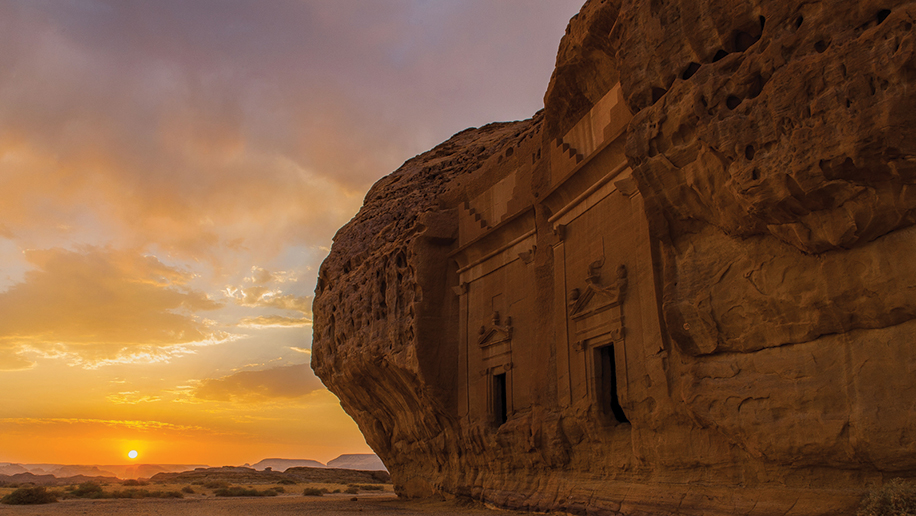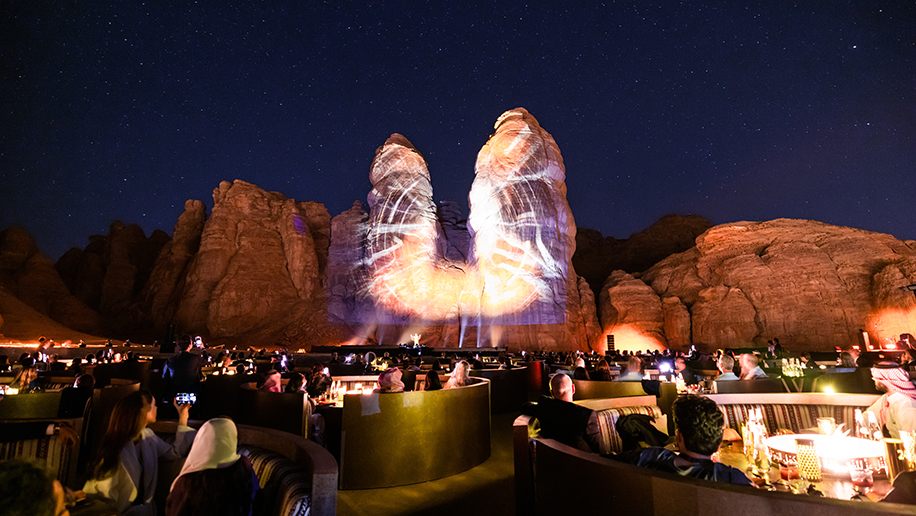
Located in the northwest of Saudi Arabia, AlUla is a sprawling 22,561 sq km location which features an oasis valley, sandstone mountains and cultural heritage sites that date back thousands of years to the reigns of the Lihyan and Nabataean kingdoms. More recently, the area came into renewed prominence two years ago when representatives from the six GCC countries met at a historic summit in AlUla, and were photographed against the stunning backdrop of the Maraya structure which is the world’s largest mirrored building.
Phillip Jones, chief destination marketing and management officer at The Royal Commission for AlUla (RCU), is tasked with creating awareness of this destination in Saudi Arabia – a country which is in the midst of an expansive and aggressive expansion of its tourism industry. “AlUla is the destination that is focused on the premium luxury market. It’s a destination that has been around continuously for the last 7,000 years. It’s a cultural heritage destination, with an emphasis on wellness and adventure experiences,” Jones told Business Traveller Middle East recently along the sidelines of the World Travel and Tourism Council’s Global Summit conducted in Riyadh.
The number of the destination’s hospitality offerings is deliberately modest, prioritising luxury instead. Jones reveals that AlUla has around 700 hotel keys at present. Accor has a significant presence in AlUla having taken over the 121-key Shaden Resort in 2019. More recently, in October 2022, Accor opened its all-tent Banyan Tree AlUla resort with a performance headlined by Mariah Carey. Habitas AlUla is another high-end property that opened back in 2021 with a strong emphasis on sustainability and is surrounded by palm groves and imposing sandstone cliffs. Meanwhile, Aman Resorts is building three properties in AlUla which includes a luxury tented camp, a resort inspired by the local architecture and heritage sites as well as a ranch-style desert resort. The first of the three Aman properties is scheduled to open this year. “In addition to those three Aman hotels that have been announced, we have six other hotel projects that are in development. At the end of the first phase – which will conclude at the end of 2025 – we should have roughly 2,000 keys. The [hospitality offerings here are] never going to be mass. It is much more focused on a premium audience that can afford to stay in these hotels and who want a unique experience that they can’t find anywhere else in the Middle East, in an unparalleled setting,” says Jones.

While the hospitality portfolio falls into place, the destination is also building an infrastructure to support the growth in visitors. In November last year, the RCU inaugurated a new 3,000 sqm hangar for private aircraft at AlUla International airport in Saudi Arabia. Many among the premium audience that Jones says are the destination’s prime target audience, will make their way there via private jets. To support larger groups, the RCU has coordinated with the country’s Civil Aviation Authority to increase AlUla’s airport’s capacity from 100,000 to 400,000 passengers annually, while its total area has also been expanded to cover 2.4 million sqm. Commercial airlines have ramped up international services to the airport too over the last few months. Saudi carrier Flynas began operating twice weekly direct flights between Cairo and AlUla last year. It also resumed services from AlUla to Dubai. In December, Saudia began flying between Paris and AlUla, while last month, Royal Jordanian started services from Amman to AlUla. “We’re going to have a tram system that will take you from the airport to Old Town and from Old Town to Hegra, with stops along the way where you can hop on and off. Phase one of this project will connect the Old Town to Hegra, and phase two will connect the airport to Old Town, all of which should happen between now and 2026,” notes Jones.
AlUla’s biggest draw is its natural heritage. The 52-hectare ancient city of Hegra (at one point the southernmost outpost of the Roman Empire) with its 111 tombs, elaborate facades cut into the sandstone outcrops and walled urban settlements was Saudi’s first lcoation to be listed as a UNESCO World Heritage Site. Bringing that into the consciousness of a younger and more technologically-savvy audience, the RCU recently introduced a to-scale and completely immersive 3D model of Hegra’s Tomb of Lihyan, Son of Kuza in the metaverse. Virtual tourists can undertake a 360-degree tour of the tomb, set amidst a realistic rendering of the destination’s desert landscape. “I think as we evolve the metaverse experience, it’s going to be more popular, particularly with the younger generation of travellers who want to see something first before they experience it in real life…and that’s the goal of the metaverse experiment,” explains Jones.

To encourage a steady flow of visitors to the location, apart from focusing on its heritage sites, the destination is also focusing on other cultural activities with a special focus on the arts. For example, a new permanent art installation was announced last year for Wadi AlFann in AlUla. Wadi AlFann, translated as Valley of the Arts, spans 65 sq km and is scheduled to open in 2024. The first five artists commissioned to create permanent artworks at the destination include Saudi artists Manal AlDowayan and Ahmed Mater alongside American artists Agnes Denes, Michael Heizer and James Turrell. This month, the Fame: Andy Warhol in AlUla exhibition is launching in collaboration with Arts AlUla and The Andy Warhol Museum. There is a constant stream of arts and heritage events being held in AlUla. In the 2022 winter season, AlUla recorded 130,000 ticket buyers for its events. It expects ticket sales in the 2023 season to exceed 200,000.
As for its contribution to the kindom’s economy, AlUla also expects to deliver SAR120 billion to Saudi’s GDP by 2035 and create 38,000 jobs by then while attracting two million visitors annually. “We’re spending billions every year – we’ve spent probably US$10 billion so far, with another US$25 billion to go. We have a lot of development and construction across the destination. And when you come, you can see the physical changes to the destination from season to season each year,” says Jones. He acknowledges that there are stumbling blocks along the way that the team are countering as they build awareness of the destination. “There are still perception issues with Saudi Arabia in the global market. The best way to convert folks into ambassadors is to have them come experience [the destination] for themselves. The other issue is supply chain issues that we’ve had during Covid, but overall we’ve been able to manage that fairly effectively,” says Jones.
AlUla is being developed in parallel to several giga projects in the kingdom including the Red Sea Project, Neom and Diriyah. “We collaborate with them. We compete with them in some ways too,” says Jones about AlUla’s coordination with the giga projects. “But we all have different market segments. I think we have the most potential for collaboration between AlUla and the Red Sea [Project] because of the very different experiences each offers. A cultural heritage experience is what we offer. A sea-and-sand experience is what the Red Sea offers. You’re going to see a lot more collaboration between AlUla and the Red Sea.
“We want people to visit the cities of Jeddah, Riyadh and the other giga projects, but of course we want them to start in AlUla.”












